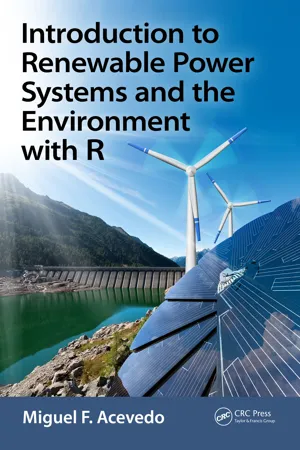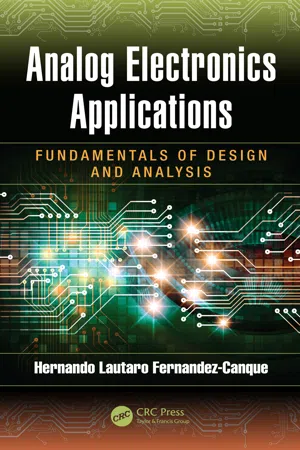Physics
Current Sources in Series
Current sources in series refer to a configuration in which multiple current sources are connected in a series circuit. In this setup, the total current flowing through the circuit is the sum of the individual currents from each source. This arrangement allows for the combination of multiple current sources to provide a cumulative current output.
Written by Perlego with AI-assistance
Related key terms
Related key terms
1 of 4
Related key terms
1 of 3
3 Key excerpts on "Current Sources in Series"
- Miguel F. Acevedo(Author)
- 2018(Publication Date)
- CRC Press(Publisher)
Conventions. Current flow direction is opposite to electron flow. Potential drops from positive to negative.The diagram of Figure 3.1 shows the typical situation where power is consumed by a load when the current is drawn from the source or supply at a rated voltageVs, which remains nearly constant as we change the load. This is a type of source is called a voltage source (Figure 3.2 ). We can distinguish another type of source, a current source , which maintains a nearly constant currentIs, regardless of voltage (Figure 3.2 ). Ideally, a voltage source would plot out as a vertical line on a graph of current versus voltage (the I-V plane), whereas a current source would plot out as a horizontal line on the I-V plane. In reality, voltage provided from a voltage source may drop as current increases, and current provided by a current source may diminish as voltage increases (Figure 3.2 ). These effects are due to internal losses (e.g., voltage drop in the voltage source) occurring at higher power demand from the load or higher value of the product VI .Figure 3.2Voltage and current sources. The bottom graphs in the voltage-current (I-V) plane illustrate the departure from constant voltage (left-hand side) and departure from constant current (right-hand side).We provide DC power using a variety of processes and devices. Two important ones are to use chemical reactions, e.g., batteries and fuel cells, and to use radiant energy, e.g., photovoltaic (PV) cells. Determining the nature of the source, whether voltage and current source, may be complicated. A battery normally behaves as a voltage source, but a fuel cell and a PV cell may exhibit current or voltage source behavior depending on the voltage and current range. For example, a PV cell behaves as a nonideal current source for lower values of voltage and can behave as a nonideal voltage source for higher values of voltage. Keep in mind that the current and voltage source concepts are just models that we can use to analyze real sources.- eBook - ePub
- Amir M. Sodagar(Author)
- 2018(Publication Date)
- CRC Press(Publisher)
Chapter 6 Current Sources/Mirrors 6.1 IntroductionCurrent sources are one of the important building blocks that play a key role in almost all fields of electronic circuits, from analog to digital, from discrete to integrated, and from voltage-mode to current-mode. The main purpose of a current source is to keep the current flowing through a circuit branch as intended regardless of the voltage across it. If this current is defined independent from other voltages/currents in the circuit, the current source will be called an independent current source. In addition, dependent current sources are used to generate a current that is a (usually linear) function of another current or voltage in the circuit. The associated circuit symbols are given in Figure 6.1 .In electronic circuits, an independent current source providing a constant current is called a current source, and a dependent current source where the output current is proportional to another current is known as a current mirror.In this chapter, basics of operation, analysis, and design of both current sources and current mirrors are explained. As will be seen, almost all current mirror configurations can also be used to make a current source. This is why sometimes the explanations for a current mirror and a similar current source of the same configuration are combined.6.2 Simple Current Source/MirrorTo implement a current source or mirror in the real world we need to employ passive and active circuit elements in such a way that the intended functionality is achieved. The simplest implementation of a current source is depicted in Figure 6.2 , in which a negative-channel metal-oxide semiconductor (NMOS) transistor is biased at a fixed current.The first restriction in implementing a current source in the real world is that both ends of a real current source cannot be arbitrarily placed. A real current source can either sink a certain current from the output node and pass it to the ground (or the negative power supply), or draw a predefined current from the positive power supply and source it to the output node. The latter can be realized by using a positive-channel metal-oxide semiconductor (PMOS) transistor (see Figure 6.3 - eBook - ePub
Analog Electronics Applications
Fundamentals of Design and Analysis
- Hernando Lautaro Fernandez-Canque(Author)
- 2016(Publication Date)
- CRC Press(Publisher)
In some cases it is difficult to determine the direction of the current, especially if there is more than one source. In general, if the direction of the current is not known to solve a circuit, we can assume a direction of the current in a component and stick to that assumption. Once the circuit is solved, if the current or voltage to be calculated comes out with a negative value, it indicates that the current circulates in the opposite direction to the assumed one. In the case of a voltage, a negative voltage indicates the polarities assumed are reverse.2.7.1SELECTION OF COMPONENTSElectrical components can have a large variation in physical size for different components and also for a given component type. In Chapter 21 , information on how to select electronic components is included.2.8KEY POINTS •An electric current is a flow of charge. •A voltage source produces an emf that can cause a current to flow. •Ideal sources have zero internal resistance. Practical voltage sources are represented by an equivalent circuit including their internal resistance. •Ohm’s law indicates that the current in a resistor is directly proportional to the voltage across it. •The equivalent resistance of n resistors connected in series is given by the sum of all n resistances. •The reciprocal of an equivalent resistance of n resistors in parallel is equal to the sum of the reciprocals of the n resistances. •A capacitor consists of two plates separated by a dielectric. •The equivalent capacitance of n capacitors in parallel is equal to the sum of n individual capacitances. •The reciprocal of an equivalent capacitance of n capacitors in series is equal to the sum of the reciprocals of the n individual capacitances.•The energy stored in a capacitor is 1/2(CV2 ) or 1/2(Q2 /C).•Inductors store energy within a magnetic field. •A wire carrying a current creates a magnetic field. •Inductors can be made by coiling a wire; a ferromagnetic material will increase the inductance.•The energy stored in an inductor is equal to 1/2(LI2
Index pages curate the most relevant extracts from our library of academic textbooks. They’ve been created using an in-house natural language model (NLM), each adding context and meaning to key research topics.
Explore more topic indexes
Explore more topic indexes
1 of 6
Explore more topic indexes
1 of 4


